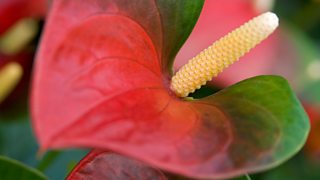Plant and flower shapes
Bridget Kendall finds out how flowers get their shapes, with professor of plant genetics Enrico Coen, photographer Andrew Zuckerman and ecology professor Lars Chittka.
What makes flowers so beautiful? Why are some leaves curly, others spiky, and others flat? Bridget Kendall brings together a panel of three experts who have some answers to nature's mysteries.
Enrico Coen is a professor of plant genetics who has been running computer simulations of how plant cells turn from bud to bloom. He's found some simple rules of nature and, joining forces with Rob Kesseler, Professor of Ceramic Art & Design at Central Saint Martins College of Arts & Design, and PhD student Tilly Eldridge, used them to create some original "organic" objects of his own at his lab at the John Innes Centre in Norwich.
Andrew Zuckerman is a photographer from New York who's got up close and personal with some of the world's most wonderful flowers in his quest to capture the essence of a flower's shape in a single photograph, shot against a plain, white background.
And ecology professor Lars Chittka helps us understand nature through the eyes of a bee, that much-coveted pollinator, which is attracted to a flower by symmetry, colour and scent. An expert in the relationships between plants and other creatures, Professor Chittka founded the Research Centre for Psychology at Queen Mary, University of London. Photo by Andrew Zuckerman (Jimson Weed, Thorn Apple
Last on
More episodes
Previous
Enrico Coen

Self-making Pots by Enrico Coen and Tilly Eldridge

Andrew Zuckerman

Andrew Zuckerman: Jimson Weed, Thorn Apple

Andrew Zuckerman: Jade Vine

Photo Credit: Andrew Zuckerman��
Andrew Zuckerman: Darwin's Star Orchid

Photo Credit: Andrew Zuckerman��
Lars Chittka

60 Second Idea
Poem by listener Catherine Diamond inspired by the original World Service edition of the programme
The Language of Flowers
by Catherine DiamondA rose maybe a rose maybe a rose
to Juliet and her lover’s nose
but not to the flower itself
that doesn’t know a phylum from a family
but may hold secrets of different kind
known only to the members of its tribe.
��
For all we know, one red-petaled wonder
may��choose��to love another
overwhelmed by mysterious passion
that defies reason and practical promiscuity.
��
Perhaps it’s not just the instinct to breed
or selection for survival alone
that guides the union of two plants;
perhaps not all is left to chance
and even in the vegetal world.
flowers have their own language of romance.Broadcast
- Sat 23 Feb 2013 11:00�鶹������ҳ��� Radio 4
Featured in...
![]()
The Power of Plants—Plants: From Roots to Riches
A selection of programmes relating to plants.


